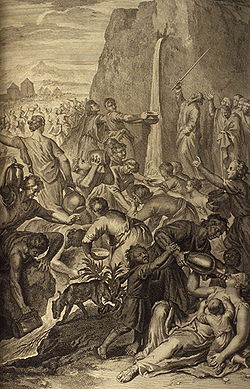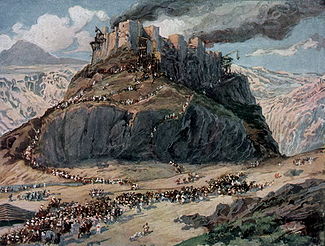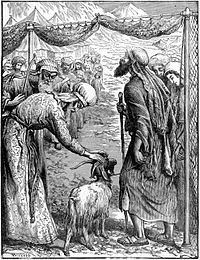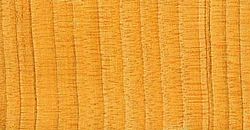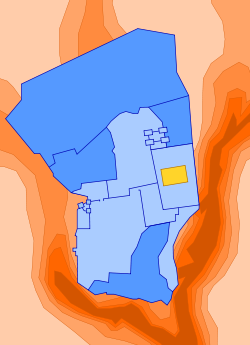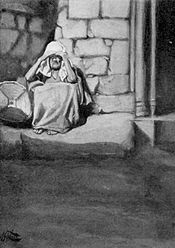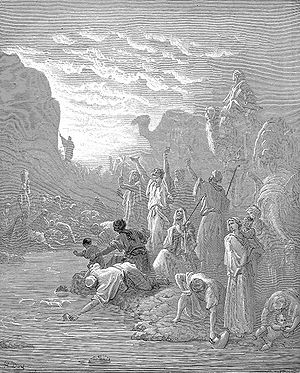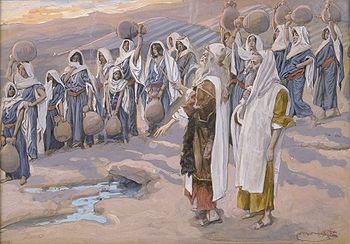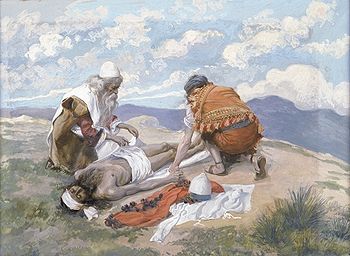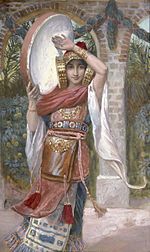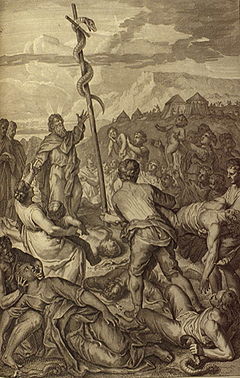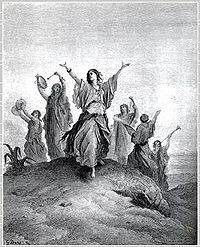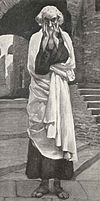- Chukat
-
Chukat, Hukath, or Chukkas (Hebrew: חֻקַּת, “decree,” — the ninth word, and the first distinctive word, in the parshah) is the 39th weekly Torah portion (parshah) in the annual Jewish cycle of Torah reading and the sixth in the book of Numbers. It constitutes Numbers 19:1–22:1. Jews in the Diaspora generally read it in late June or July.
The lunisolar Hebrew calendar contains up to 55 weeks, the exact number varying among years. In most years (for example, 2011, 2012, 2013, 2014, 2015, 2016, and 2017), parshah Chukat is read separately. In some years (for example, 2009, when the second day of Shavuot fell on a Sabbath in the Diaspora), parshah Chukat is combined with the subsequent parshah, Balak, to help achieve the needed number of weekly readings.
Jews also read the first part of the parshah, Numbers 19:1–22, in addition to the regular weekly Torah portion, on the Sabbath after Purim, called Shabbat Parah. On Shabbat Parah, a reader chants the regular weekly Torah portion first, and then a reader chants the chapter of the red cow (parah adumah). Shabbat Parah occurs shortly before Passover, and Numbers 19:1–22 sets out the procedure by which the Israelites could purify themselves from the contamination caused by a corpse, and so prepare for the pilgrimage festival of Passover.
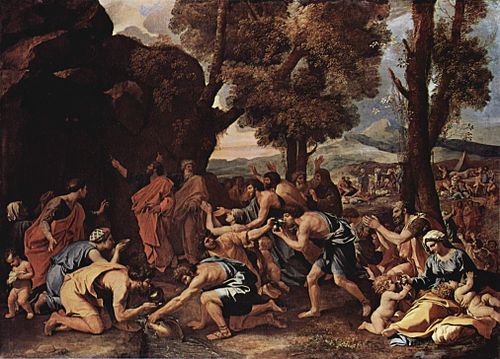 Moses Striking Water from the Rock (painting circa 1633–1635 by Nicolas Poussin)
Moses Striking Water from the Rock (painting circa 1633–1635 by Nicolas Poussin)
Contents
Summary
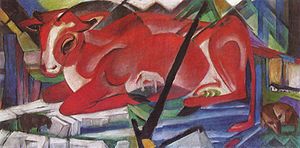 The World Cow (1913 painting by Franz Marc)
The World Cow (1913 painting by Franz Marc)
The red heifer
God told Moses and Aaron to instruct the Israelites the ritual law of the red heifer (פָרָה אֲדֻמָּה, parah aduma) used to create water of lustration. (Numbers 19:1–2.) The heifer (a cow that had not borne a calf) had to be without blemish, have no defect, and not have borne a yoke. (Numbers 19:2.) Eleazar the priest was to take it outside the camp, observe its slaughter, and take some of its blood with his finger and sprinkle it seven times toward the Tabernacle. (Numbers 19:3–4.) The cow was to be burned in its entirety along with cedar wood, hyssop, and crimson stuff. (Numbers 19:5–6.) The priest and the one who burned the cow were both to wash their garments, bathe in water, and be unclean until evening. (Numbers 19:7–8.) The ashes of the cow were to be used to create the water of lustration. (Numbers 19:9.)
One who touched the corpse of any human being was to be unclean for seven days. (Numbers 19:10–11.) On the third and seventh days, the person who had touched the corpse was to cleanse with the water of lustration and then be clean. (Numbers 19:12.) One who failed to do so would remain unclean, would defile the Tabernacle, and would be cut off from Israel. (Numbers 19:12–13.)
When a person died in a tent, whoever entered the tent was to be unclean seven days, and every open vessel in the tent was to be unclean. (Numbers 19:14–15.) In the open, anyone who touched a corpse, bone, or a grave was to be unclean seven days. (Numbers 19:16.)
A person who was clean was to add fresh water to ashes of the red cow, dip hyssop it in the water, and sprinkle the water on the tent, the vessels, and people who had become unclean. (Numbers 19:17–18.) The person who sprinkled the water was then to wash his clothes, bathe in water, and be clean at nightfall. (Numbers 19:19.)
Anyone who became unclean and failed to cleanse himself was to be cut off from the congregation. (Numbers 19:20.) The person who sprinkled the water of lustration was to wash his clothes, and whoever touched the water of lustration, whatever he touched, and whoever touched him were to be unclean until evening. (Numbers 19:21–22.)
Miriam’s death
The Israelites arrived at Kadesh in the wilderness of Zin, and Miriam died and was buried there. (Numbers 20:1.)
 Moses Brings Forth Water out of the Rock (1304 fresco by Giotto di Bondone at the Scrovegni Chapel, Padua)
Moses Brings Forth Water out of the Rock (1304 fresco by Giotto di Bondone at the Scrovegni Chapel, Padua)
Water from a rock
The people were without water, and they complained against Moses and Aaron. (Numbers 20:2–5.) Moses and Aaron fell on their faces at the entrance of the Tent of Meeting, and the Presence of God appeared to them, telling them to take the rod and order the rock to yield its water. (Numbers 20:6–8.) Moses took the rod, assembled the congregation in front of the rock, and said to them: “Listen, you rebels, shall we get water for you out of this rock?” (Numbers 20:9–10.) Then Moses struck the rock twice with his rod, out came water, and the community and their animals drank. (Numbers 20:11.) But God told Moses and Aaron: “Because you did not trust Me enough to affirm My sanctity in the sight of the Israelite people, therefore you shall not lead this congregation into the land that I have given them.” (Numbers 20:12.)
Emissary to Edom
Moses sent messengers to the king of Edom asking him to allow the Israelites to cross Edom, without passing through fields or vineyards, and without drinking water from wells. (Numbers 20:14–17.) But the Edomites would not let the Israelites pass through, and turned out in heavy force to block their way, and the Israelites turned away. (Numbers 20:18–21.)
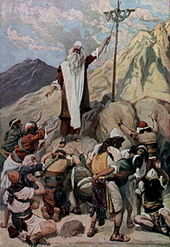 The Brazen Serpent (watercolor circa 1896–1902 by James Tissot)
The Brazen Serpent (watercolor circa 1896–1902 by James Tissot)
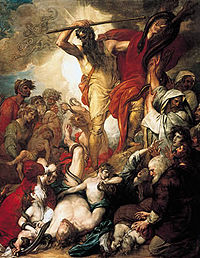 The Brazen Serpent (1790 painting by Benjamin West)
The Brazen Serpent (1790 painting by Benjamin West)
Aaron’s death
At Mount Hor, God told Moses and Aaron: “Let Aaron be gathered to his kin: he is not to enter the land that I have assigned to the Israelite people, because you disobeyed my command about the waters of Meribah.” (Numbers 20:23–24.) Moses took Aaron and his son Eleazar up on Mount Hor, and there he stripped Aaron of his vestments and put them on Eleazar, and Aaron died there. (Numbers 20:25–28.) The Israelites mourned Aaron 30 days. (Numbers 20:29.)
Victory over Arad
The king of Arad engaged the Israelites in battle and took some of them captive. (Numbers 21:1.) The Israelites vowed that if God gave them victory, they would destroy Arad. (Numbers 21:2.) God delivered up the Canaanites, and the Israelites killed them and destroyed their cities, calling the place Hormah. (Numbers 21:3.)
Serpents
The people grew restive and spoke against God and Moses, so God let loose serpents that killed many of the Israelites. (Numbers 21:4–6.) The people came to Moses, admitted their sin by speaking against God, and asked Moses to intercede with God to take away the serpents, and Moses did so. (Numbers 21:7.) God told Moses to mount a serpent figure on a standard, saying: “If anyone who is bitten looks at it, he shall recover.” (Numbers 21:8.)
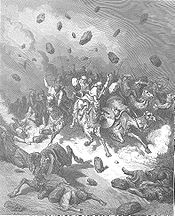 Destruction of the Army of the Amorites (engraving by Gustave Doré from the 1865 La Sainte Bible)
Destruction of the Army of the Amorites (engraving by Gustave Doré from the 1865 La Sainte Bible)
Victories over Sihon and Og
The Israelites traveled on, and sent messengers to Sihon, king of the Amorites, asking that he allow them to pass through his country, without entering the fields or vineyards, and without drinking water from wells. (Numbers 21:21–22.) But Sihon would not let Israel pass through his territory and engaged the Israelites in battle. (Numbers 21:23.) The Israelites defeated the Amorites and took possession of their land and towns. (Numbers 21:24–25.)
Then the Israelites marched on, and King Og of Bashan engaged them in battle. (Numbers 21:33.) The Israelites defeated his forces and took possession of his country. (Numbers 21:35.) The Israelites then marched to the steppes of Moab, across the Jordan River from Jericho. (Numbers 22:1.)
In inner-biblical interpretation
Numbers chapter 19
Corpse contamination
The discussion of the red cow mixture for decontamination from corpse contamination in Numbers 19 is one of a series of passages in the Hebrew Bible setting out the teaching that contact with the dead is antithetical to purity.
In Leviticus 21:1–5, God instructed Moses to direct the priests not to allow themselves to become defiled by contact with the dead, except for a mother, father, son, daughter, brother, or unmarried sister. And the priests were not to engage in mourning rituals of making baldness upon their heads, shaving off the corners of their beards, or cutting their flesh.
In Numbers 5:1–4, God instructed Moses to command the Israelites to put out of the camp every person defiled by contact with the dead, so that they would not defile their camps, in the midst of which God dwelt.
Numbers 19 sets out a procedure for a red cow mixture for decontamination from corpse contamination.
In its profession associated with tithing, Deuteronomy 26:13–14 instructed Israelites to aver that they had not eaten from the tithe in mourning, nor put away any of it while unclean, nor given any of it to the dead.
In Ezekiel 43:6–9, the prophet Ezekiel cites the burial of kings within the Temple as one of the practices that defiled the Temple and cause God to abandon it.
In the Hebrew Bible, uncleanness has a variety of associations. Leviticus 11:8, 11; 21:1–4, 11; and Numbers 6:6–7; and 19:11–16; associate it with death. And perhaps similarly, Leviticus 12 associates it with childbirth, and Leviticus 13–14 associates it with skin disease. Leviticus 15 associates it with various sexuality-related events. And Jeremiah 2:7, 23; 3:2; and 7:30; and Hosea 6:10 associate it with contact with the worship of alien gods.
In classical rabbinic interpretation
Numbers chapter 19
Tractate Parah in the Mishnah and Tosefta interpreted the laws of the red cow in Numbers 19:1–22. (Mishnah Parah 1:1–12:11; Tosefta Parah 1:1–12:19.)
Rabbi Tanhum son of Rabbi Hannilai taught that Numbers 19 was one of two sections in the Torah (along with Leviticus 21, on corpse contamination) that Moses gave the Israelites in writing that are both pure, dealing with the law of purity. Rabbi Tanhum taught that they were given on account of the tribe of Levi, of whom it is written (in Malachi 3:3), “he [God’s messenger] shall purify the sons of Levi and purge them.” (Leviticus Rabbah 26:3.)
The Mishnah and Tosefta taught that if the month of Adar began on a Sabbath, then the section on the red cow in Numbers 19:1–22 was read on the third Sabbath of the month (thus preceding Passover, so as to caution the people to purify themselves in preparation for eating the Passover sacrifice). (Mishnah Megillah 3:4; Tosefta Megillah 3:3.)
Rabbi Joshua of Siknin taught in the name of Rabbi Levi that the Evil Inclination criticizes four laws as without logical basis, and Scripture uses the expression “statute” (chuk) in connection with each: the laws of (1) a brother’s wife (in Deuteronomy 25:5–10), (2) mingled kinds (in Leviticus 19:19 and Deuteronomy 22:11), (3) the scapegoat (in Leviticus 16), and (4) the red cow (in Numbers 19). In connection with the red cow, the Mishnah noted the paradox that the garments of all those who took any part in the preparation of the red cow became defiled, but the cow itself made garments ritually clean. (Mishnah Parah 4:4.) And Numbers 19:1 applies the term “statute” to the red cow. (Numbers Rabbah 19:5; see also Babylonian Talmud Yoma 67b on “statutes” generally.)
A midrash taught that an idolater once asked Rabban Johanan ben Zakkai about the red cow, likening its procedures to witchcraft. Rabban Johanan asked the idolater what he had seen done for a man possessed by a demon of madness. The idolater explained how in such a case, they would bring roots, make them smoke under the madman, sprinkle water on the man, and the demon would flee. Rabban Johanan told him that the red cow dealt similarly with the spirit of uncleanness, as Zechariah 13:2 says: “And also I will cause the prophets and the unclean spirit to pass out of the land.” Rabban Johanan told him that when they sprinkled the water of purification on the unclean, the spirit of uncleanness fled. But when the idolater had gone, Rabban Johanan’s disciples told Rabban Johanan that they saw that he had put off the idolater with a mere makeshift, and asked him what explanation Rabban Johanan would give them. Rabban Johanan told his disciples that the dead did not defile nor the water purify; God had merely laid down a statute, issued a decree, and commanded that we not transgress the decree, as Numbers 19:2 says: “This is the statute of the law.” (Numbers Rabbah 19:8.)
Expounding upon the commandment of the red cow in Numbers 19:2, Rabbi Jose ben Hanina taught that God told Moses the reason for the commandment, but to everyone else it would remain merely a statute. (Numbers Rabbah 19:6.)
All other communal sacrifices were of male animals, but the red cow was of a female animal. Rabbi Aibu explained the difference with a parable: When a handmaiden’s boy polluted a king’s palace, the king called on the boy’s mother to clear away the filth. In the same way, God called on the red cow to come and atone for the incident of the golden calf. (Numbers Rabbah 19:8.)
Rabbi Eliezer ruled that the calf (עֶגְלָה, eglah) prescribed in Deuteronomy 21:3–6 had to be no more than one year old and the red cow (פָרָה, parah) prescribed in Numbers 19:2 had to be two years old. But the Sages ruled that the calf could be even two years old and the red cow could be three or four years old. Rabbi Meir ruled that the red cow could be even five years old, but they did not wait with an older cow, as it might in the meantime grow some black hairs and thus become invalid. (Mishnah Parah 1:1.)
Rabbi Eliezer ruled that a red cow that was pregnant was nonetheless valid, but the Sages ruled it invalid. Rabbi Eliezer ruled that the red cow could not be purchased from Gentiles, but the Sages ruled that such cow could be valid. (Mishnah Parah 2:1.) If the horns or the hoofs of the red cow were black, they were chopped off, and the red cow was then valid. The cow’s eye, teeth, and tongue could cause no invalidity. And a dwarf-like cow was nonetheless valid. If the red cow had a sebaceous cyst and they cut it off, Rabbi Judah ruled the cow invalid, but Rabbi Simeon ruled it invalid only if no red hair grew in its place. (Mishnah Parah 2:2.)
A red cow born by a caesarean section, the hire of a harlot, or the price of a dog was invalid. Rabbi Eliezer ruled it valid, for Deuteronomy 23:19 states, “You shall not bring the hire of a harlot or the price of a dog into the house of the Lord your God,” and the red cow was not brought into the Temple. The Mishnah taught that all blemishes that caused consecrated animals to be invalid as sacrifices also caused the red cow to be invalid. If one had ridden on the cow, leaned on it, hung on its tail, crossed a river with its help, doubled up its leading rope, or put one’s cloak on it, the cow was invalid. But if one had only fastened it by its leading rope or made for it a sandal to prevent it from slipping, or spread one’s cloak on it because of flies, it remained valid. The general rule was that wherever one did something for its own sake, the cow remained valid; but if one did something for the sake of another purpose, it invalidated the cow. (Mishnah Parah 2:3.) If a bird rested on the cow, it remained valid. If a bull mounted it, it became invalid; but Rabbi Judah ruled that if people brought the bull to mate with the cow, the cow became invalid, but if the bull did so on its own, the cow remained valid. (Mishnah Parah 2:4.)
If a cow had two black or white hairs growing within one follicle, it was invalid. Rabbi Judah said even within one hollow. If the hairs grew within two adjacent follicles, the cow was invalid. Rabbi Akiba ruled that even if there were four or even five non-red hairs, if they were dispersed, they could be plucked out. Rabbi Eliezer ruled that even as many as 50 such hairs could be plucked. But Rabbi Joshua ben Bathyra ruled that even if it had only one non-red hair on its head and one on its tail, it was invalid. If the cow had two hairs in one follicle with their roots black and their tips red or with their roots red and their tips black, Rabbi Meir taught that what was visible determined validity; but the Sages ruled that validity followed the root. (Mishnah Parah 2:5.)
Rav Judah reported in Samuel’s name an account of the rarity of completely red cows: When they asked Rabbi Eliezer how far the honor due parents extended, Rabbi Eliezer told of a non-Jew from Ashkelon named Dama son of Nethinah. The Sages offered Dama a profit of 600,000 gold denarii (or Rav Kahana said 800,000 denarii) in exchange for jewels that he had that the Sages could use in the ephod, but as the key to the jewels lay under Dama’s father’s pillow, Dama declined the offer so as not to trouble his father. The next year, God rewarded Dama by causing a red cow to be born in his herd. When the Sages went to buy it, Dama told them that he knew that he could ask for all the money in the world and they would pay it, but he asked for only the money that he had lost in honoring his father. (Babylonian Talmud Kiddushin 31a.)
Rabbi Eliezer noted that both Leviticus 16:27 (with regard to burning the Yom Kippur sin offerings) and Numbers 19:3 (with regard to slaughtering the red cow) say “outside the camp.” Rabbi Eliezer concluded that both actions had to be conducted outside the three camps of the Israelites, and in the time of the Temple in Jerusalem, both actions had to be conducted to the east of Jerusalem. (Babylonian Talmud Yoma 68a.)
 hyssop (1885 painting by Otto Wilhelm Thomé)
hyssop (1885 painting by Otto Wilhelm Thomé)
Rabbi Isaac contrasted the red cow in Numbers 19:3–4 and the bull that the High Priest brought for himself on Yom Kippur in Leviticus 16:3–6. Rabbi Isaac taught that a lay Israelite could slaughter one of the two, but not the other, but Rabbi Isaac did not know which was which. The Gemara reported that Rav and Samuel disagreed about the answer. Rav held it invalid for a lay Israelite to slaughter the red cow and valid for a lay Israelite to slaughter the High Priest’s bull, while Samuel held it invalid for a lay Israelite to slaughter the High Priest’s bull and valid for a lay Israelite to slaughter the red cow. The Gemara reported that Rav Zeira (or some say Rav Zeira in the name of Rav) said that the slaughtering of the red cow by a lay Israelite was invalid, and Rav deduced from this statement the importance that Numbers 19:3 specifies “Eleazar” and Numbers 19:2 specifies that the law of the red cow is a “statute” (and thus required precise execution). But the Gemara challenged Rav’s conclusion that the use of the terms “Eleazar” and “statute” in Numbers 19:2–3 in connection with the red cow decided the matter, for in connection with the High Priest’s bull, Leviticus 16:3 specifies “Aaron,” and Leviticus 16:34 calls the law of Leviticus 16 a “statute,” as well. The Gemara supposed that the characterization of Leviticus 16:34 of the law as a “statute” might apply to only the Temple services described in Leviticus 16, and the slaughtering of the High Preist’s bull might be regarded as not a Temple service. But the Gemara asked whether the same logic might apply to the red cow, as well, as it was not a Temple service, either. The Gemara posited that one might consider the red cow to have been in the nature of an offering for Temple upkeep. Rav Shisha son of Rav Idi taught that the red cow was like the inspection of skin diseases in Leviticus 13–14, which was not a Temple service, yet required a priest's participation. The Gemara then turned to Samuel’s position, that a lay Israelite could kill the red cow. Samuel interpreted the words “and he shall slay it before him” in Numbers 19:3 to mean that a lay Israelite could slaughter the cow as Eleazar watched. The Gemara taught that Rav, on the other hand, explained the words “and he shall slay it before him” in Numbers 19:3 to enjoin Eleazar not to divert his attention from the slaughter of the red cow. The Gemara reasoned that Samuel deduced that Eleazer must not divert his attention from the words “and the heifer shall be burnt in his sight” in Numbers 19:5 (which one could similarly read to imply an injunction for Eleazar to pay close attention). And Rav explained the words “in his sight” in one place to refer to the slaughtering, and in the other to the burning, and the law enjoined his attention to both. In contrast, the Gemara posited that Eleazar might not have needed to pay close attention to the casting in of cedarwood, hyssop, and scarlet, because they were not part of the red cow itself. (Babylonian Talmud Yoma 42a–b.)
Ulla interpreted the words “and he shall bring it forth” in Numbers 19:3 to teach that he could not bring forth another cow with the red cow. As the Mishnah taught (in Mishnah Parah 3:7), if the red cow refused to go forth, one could not send a black cow with the red cow, lest people say that they slaughtered a black cow, nor could two red cows be brought forth together, lest people say that they slaughtered two. Rabbi (or others say Rabbi Jose) taught that a second cow was not to be taken out because Numbers 19:3 says “and he shall bring it forth” and “it” implies by itself. The Gemara taught that the teaching of the Mishnah and Rabbi differed in the case of whether one could bring forth a donkey with the red cow. (According to the Mishnah, that would be permitted, because the presence of the donkey would not mislead people that they were sacrificing the donkey, but according to Rabbi, it would be forbidden, for “it” excludes permission for any other animal to be brought forth together with the red cow.) (Babylonian Talmud Yoma 42b.)
Ulla interpreted the words “And he shall slay it” in Numbers 19:3 to teach that one could not slaughter any other one with it. (Babylonian Talmud Yoma 43a.)
A midrash noted that God commanded the Israelites to perform certain precepts with similar material from trees: God commanded that the Israelites throw cedar wood and hyssop into the red cow mixture of Numbers 19:6 and use hyssop to sprinkle the resulting waters of lustration in Numbers 19:18; God commanded that the Israelites use cedar wood and hyssop to purify those stricken with skin disease in Leviticus 14:4–6; and in Egypt God commanded the Israelites to use the bunch of hyssop to strike the lintel and the two side-posts with blood in Exodus 12:22. (Exodus Rabbah 17:1.) Noting that the cedar was among the tallest of tall trees and the hyssop was among the lowest of low plants, the midrash associated the cedar with arrogance and the hyssop with humility. (Numbers Rabbah 19:3; Ecclesiastes Rabbah 7:35.)
Rabbi Isaac noted two red threads, one in connection with the red cow in Numbers 19:6, and the other in connection with the scapegoat in the Yom Kippur service of Leviticus 16:7–10 (which Mishnah Yoma 4:2 indicates was marked with a red thread). Rabbi Isaac had heard that one required a definite size, while the other did not, but he did not know which was which. Rav Joseph reasoned that because (as Mishnah Yoma 6:6 explains) the red thread of the scapegoat was divided, that thread required a definite size, whereas that of the red cow, which did not need to be divided, did not require a definite size. Rami bar Hama objected that the thread of the red cow required a certain weight (to be cast into the flames, as described in Numbers 19:6). Rava said that the matter of this weight was disputed by Tannaim (as explained below). Abaye objected (based on Mishnah Parah 3:11) that they wrapped the red thread together with the cedar wood and hyssop. Rabbi Hanin said in the name of Rav that if the cedar wood and the red thread were merely caught by the flame, they were used validly. They objected to Rabbi Hanin based on a Baraita which taught that if the thread caught fire in midair, they brought another thread to prepare the water of lustration. Abaye reconciled the two opinions by interpreting the Baraita to speak of a flame that blazed high above the cow, and interpreting Rabbi Hanin to speak of a subdued flame that consumed the thread near the burning cow. Rava explained the dispute among Tannaim about the weight of the red thread in connection with the red cow. Rabbi taught that they wrapped the cedar wood and hyssop together with the red thread so that they formed one bunch. Rabbi Eleazar the son of Rabbi Simeon said that they wrapped them together so that they had sufficient weight to fall into the midst of the burning cow. (Babylonian Talmud Yoma 41b.)
When Rav Dimi came from the Land of Israel, he said in the name of Rabbi Johanan that there were three red threads: one in connection with the red cow, the second in connection with the scapegoat, and the third in connection with the person with skin disease (the m’tzora) in Leviticus 14:4. Rav Dimi reported that one weighed ten zuz, another weighed two selas, and the third weighed a shekel, but he could not say which was which. When Rabin came, he said in the name of Rabbi Jonathan that the thread in connection with the red cow weighed ten zuz, that of the scapegoat weighed two selas, and that of the person with skin disease weighed a shekel. Rabbi Johanan said that Rabbi Simeon ben Halafta and the Sages disagreed about the thread of the red cow, one saying that it weighed ten shekels, the other that it weighed one shekel. Rabbi Jeremiah of Difti said to Ravina that they disagreed not about the thread of the red cow, but about that of the scapegoat. (Babylonian Talmud Yoma 41b–42a.)
The Mishnah taught that seven days before the burning of the red cow, they removed the priest who was to burn the cow from his house to a room called the stone chamber facing the north-eastern corner of the Temple. The Mishnah taught that throughout the seven days, they sprinkled on the priest a mixture of all the sin-offerings that were there, but Rabbi Jose taught that they sprinkled only on the third and the seventh days. And Rabbi Hanina the Deputy High Priest taught that on the priest who was to burn the cow they sprinkled all the seven days, but on the one who was to perform the service on Yom Kippur they sprinkled only on the third and the seventh days. (Mishnah Parah 3:1.)
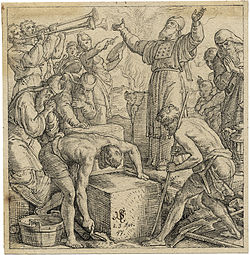 The rebuilding of the Temple in Jerusalem under Ezra and Nehemiah (1847 drawing by Julius Schnorr von Carolsfeld')
The rebuilding of the Temple in Jerusalem under Ezra and Nehemiah (1847 drawing by Julius Schnorr von Carolsfeld')
To protect against defilement from contact with the dead, they built courtyards over bedrock, and left beneath them a hollow to serve as protection against a grave in the depths. They used to bring pregnant women there to give birth and rear their children in this ritually pure place. They placed doors on the backs of oxen and placed the children upon them with stone cups in their hands. When the children reached the pool of Siloam, the children stepped down, filled the cups with water, and then climbed back up on the doors. Rabbi Jose said that each child used to let down his cup and fill it from on top of the oxen. (Mishnah Parah 3:2.) When the children arrived at the Temple Mount with the water, they got down. Beneath the Temple Mount and the Temple courtyards was a hollow, which protected against contamination from a grave in the depths. At the entrance of the court of the women, they kept a jar of the ashes of the sin-offerings. (Mishnah Parah 3:3.) If they did not find the residue of the ashes of seven red cows, they performed the sprinkling with those of six, of five, of four, of three, of two or of one. (Mishnah Parah 3:5.)
Rabbi Meir taught that Moses prepared the first red cow ashes, Ezra prepared the second, and five were prepared since then. But the Sages taught that seven were prepared since Ezra. They said that Simeon the Just and Johanan the High Priest prepared two each, and Eliehoenai the son of Hakof, Hanamel the Egyptian, and Ishmael the son of Piabi each prepared one. (Mishnah Parah 3:5.)
The Mishnah taught that they bound the red cow with a bast rope and placed it on the pile with its head towards the south and its face towards the west. The priest stood on the east side facing west. He slaughtered the cow with his right hand and received the blood with his left hand. But Rabbi Judah said that he received the blood with his right hand, put it on his left hand, and then sprinkled with his right hand. He dipped his finger in the blood and sprinkled it towards the Holy of Holies seven times, dipping once for each sprinkling. (Mishnah Parah 3:9.)
The Mishnah taught that during the time of the Temple in Jerusalem, all the walls of the Temple were high except the eastern wall. This was so that the priest who burned the red cow, while standing on the top of the Mount of Olives, might see the door of the main Temple building when he sprinkled the blood. (Mishnah Middot 2:4.)
The Mishnah taught that when the priest had finished the sprinkling, he wiped his hand on the body of the cow, climbed down, and kindled the fire with wood chips. But Rabbi Akiba said that he kindled the fire with dry branches of palm trees. (Mishnah Parah 3:9.) When the cow’s carcass burst in the fire, the priest took up a position outside the pit, took hold of the cedar wood, hyssop, and scarlet wool, and said to the observers: “Is this cedar wood? Is this hyssop? Is this scarlet wool?” He repeated each question three times, and the observers answered “Yes” three times to each question. (Mishnah Parah 3:10.) The priest then wrapped the cedar wood, hyssop, and scarlet wool together with the ends of the wool and cast them into the burning pyre. When the fire burned out, they beat the ashes with rods and then sifted them with sieves. They then divided the ashes into three parts: One part was deposited on the rampart, one on the Mount of Olives, and one was divided among the courses of priests who performed the Temple services in turn. (Mishnah Parah 3:11.)
Reading Numbers 19:8, the Mishnah noted that the person who burned the red cow (as well as the person who burned the bulls burned pursuant to Leviticus 4:3–21 or 16:27 and the person who led away the scapegoat pursuant to Leviticus 16:7–10 and 26) rendered unclean the clothes worn while so doing. But the red cow (as well as the bull and the scapegoat) did not itself render unclean clothes with which it came in contact. The Mishnah imagined the clothing saying to the person: “Those that render you unclean do not render me unclean, but you render me unclean.” (Mishnah Parah 8:3.)
Tractate Oholot in the Mishnah and Tosefta interpreted the laws of corpse contamination in Numbers 19:14–16. (Mishnah Oholot 1:1–18:10; Tosefta Oholot 1:1–18:18.)
Ulla taught that the Rabbis ruled the skin of dead people contaminating so as to prevent people from fashioning their parents’ skin into keepsakes. (Babylonian Talmud Chullin 122a.) Similarly, the Mishnah taught that the Sadducees mocked the Pharisees, because the Pharisees taught that the Holy Scrolls rendered unclean the hands that touched them, but the books of Homer did not. In response, Rabban Johanan ben Zakkai noted that both the Pharisees and the Saducees taught that a donkey’s bones were clean, yet the bones of Johanan the High Priest were unclean. The Saducees replied to Rabban Johanan that the uncleanness of human bones flowed from the love for them, so that people should not make keepsakes out of their parents’ bones. Rabban Johanan replied that the same was true of the Holy Scriptures, for their uncleanness flowed from the love for them. Homer’s books, which were not as precious, thus did not render unclean the hands that touched them. (Mishnah Yadayim 4:6.)
Rabbi Akiba interpreted the words “and the clean person shall sprinkle upon the unclean” in Numbers 19:19 to teach that if the sprinkler sprinkled upon an unclean person, the person became clean, but if he sprinkled upon a clean person, the person became unclean. The Gemara explained that Rabbi Akiba’s view hinged on the superfluous words “upon the unclean,” which must have been put in Numbers 19:19 to teach this. But the Sages held that these effects of sprinkling applied only in the case of things that were susceptible to uncleanness. The Gemara explained that the Rabbis’ view could be deduced from the logical proposition that the greater includes the lesser: If sprinkling upon the unclean makes clean, how much more so should sprinkling upon the clean keep clean or make cleaner? And the Gemara said that it is with reference to Rabbi Akiba’s position that Solomon said in Ecclesiastes 7:23: “I said, ‘I will get wisdom,’ but it is far from me.” That is, even Solomon could not explain it. (Babylonian Talmud Yoma 14a.)
Rabbi Joshua ben Kebusai taught that all his days he had read the words “and the clean person shall sprinkle upon the unclean” in Numbers 19:19 and only discovered its meaning from the storehouse of Yavneh. And from the storehouse of Yavneh Rabbi Joshua ben Kebusai learned that one clean person could sprinkle even a hundred unclean persons. (Tosefta Demai 1:14, Makhshirin 3:15.)
Numbers chapter 20
Rabbi Ammi taught that the Torah places the account of Miriam's death in Numbers 20:1 immediately after the laws of the red cow in Numbers 19:1–22 to teach that even as the red cow provided atonement, so the death of the righteous provides atonement for those whom they leave behind. (Babylonian Talmud Moed Katan 28a.)
Rabbi Eleazar taught that Miriam died with a Divine kiss, just as Moses had. As Deuteronomy 34:5 says, “So Moses the servant of the Lord died there in the land of Moab by the mouth of the Lord,” and Numbers 20:1 says, “And Miriam died there” — both using the word “there” — Rabbi Eleazar deduced that both Moses and Miriam died the same way. Rabbi Eleazar explained that Numbers 20:1 does not say that Miriam died “by the mouth of the Lord” because it would be indelicate to say so. (Babylonian Talmud Moed Katan 28a.)
Rabbi Jose the son of Rabbi Judah taught that three good leaders arose for Israel — Moses, Aaron, and Miriam — and for their sake Providence conferred three good things on Israel — the well that accompanied the Israelites on their journeys for the merit of Miriam, the pillar of cloud for the merit of Aaron, and the manna for the merit of Moses. When Miriam died, the well disappeared, as Numbers 20:1 reports, “And Miriam died there,” and immediately thereafter Numbers 20:2 reports, “And there was no water for the congregation.” The well returned for the merit of Moses and Aaron. When Moses died, the well, the pillar of cloud, and the manna all disappeared, as Zechariah 11:8 reports, “And I cut off the three shepherds in one month.” (Babylonian Talmud Taanit 9a.)
The Mishnah counted the well that accompanied the Israelites through the desert in the merit of Miriam, or others say, the well that Moses opened by striking the rock in Numbers 20:11, among ten miraculous things that God created at twilight on the eve of the first Sabbath. (Mishnah Avot 5:6.)
A midrash interpreted Numbers 20:11 to teach that Moses struck the rock once and small quantities of water began to trickle from the rock, as Psalm 78:20 says, “Behold, He smote the rock, that waters issued.” Then the people ridiculed Moses, asking if this was water for sucklings, or babes weaned from milk. So Moses lost his temper and struck the rock “twice; and water came forth abundantly” (in the words of Numbers 20:11), overwhelming all those who had railed at Moses, and as Psalm 78:20 says, “And streams overflowed.” (Numbers Rabbah 19:9.)
Reading God’s criticism of Moses in Numbers 20:12, “Because you did not believe in Me,” a midrash asked whether Moses had not previously said worse when in Numbers 11:22, he showed a greater lack of faith and questioned God’s powers asking: “If flocks and herds be slain for them, will they suffice them? Or if all the fish of the sea be gathered together for them, will they suffice them?” The midrash explained by relating the case of a king who had a friend who displayed arrogance towards the king privately, using harsh words. The king did not, however, lose his temper with his friend. Later, the friend displayed his arrogance in the presence of the king’s legions, and the king sentenced his friend to death. So also God told Moses that the first offense that Moses committed (in Numbers 11:22) was a private matter between Moses and God. But now that Moses had committed a second offense against God in public, it was impossible for God to overlook it, and God had to react, as Numbers 20:12 reports, “To sanctify Me in the eyes of the children of Israel.” (Numbers Rabbah 19:10.)
Rabbi Simeon ben Eleazar taught that Moses and Aaron died because of their sin, as Numbers 20:12 reports God told them, “Because you did not believe in Me . . . you shall not bring this assembly into the land that I have given them.” Rabbi Simeon ben Eleazar thus taught that had they believed in God, their time would not yet have come to depart from the world. (Babylonian Talmud Shabbat 55b.)
The Gemara implied that the sin of Moses in striking the rock at Meribah compared favorably to the sin of David. The Gemara reported that Moses and David were two good leaders of Israel. Moses begged God that his sin be recorded, as it is in Numbers 20:12, 20:23–24, and 27:13–14, and Deuteronomy 32:51. David, however, begged that his sin be blotted out, as Psalm 32:1 says, “Happy is he whose transgression is forgiven, whose sin is pardoned.” The Gemara compared the cases of Moses and David to the cases of two women whom the court sentenced to be lashed. One had committed an indecent act, while the other had eaten unripe figs of the seventh year in violation of Leviticus 25:6. The woman who had eaten unripe figs begged the court to make known for what offense she was being flogged, lest people say that she was being punished for the same sin as the other woman. The court thus made known her sin, and the Torah repeatedly records the sin of Moses. (Babylonian Talmud Yoma 86b.)
Resh Lakish taught that Providence punishes bodily those who unjustifiably suspect the innocent. In Exodus 4:1, Moses said that the Israelites “will not believe me,” but God knew that the Israelites would believe. God thus told Moses that the Israelites were believers and descendants of believers, while Moses would ultimately disbelieve. The Gemara explained that Exodus 4:13 reports that “the people believed” and Genesis 15:6 reports that the Israelites’ ancestor Abraham “believed in the Lord,” while Numbers 20:12 reports that Moses “did not believe.” Thus, Moses was smitten when in Exodus 4:6 God turned his hand white as snow. (Babylonian Talmud Shabbat 97a.)
A midrash employed a parable to explain why God held Aaron as well as Moses responsible when Moses struck the rock, as Numbers 20:12 reports, “and the Lord said to Moses and Aaron: ‘Because you did not believe in Me.’” The midrash told how a creditor came to take away a debtor's granary and took both the debtor's granary and the debtor's neighbor’s granary. The debtor asked the creditor what his neighbor had done to warrant such treatment. Similarly, Moses asked God what Aaron had done to be blamed when Moses lost his temper. The midrash taught that it on this account that Deuteronomy 33:8 praises Aaron, saying, “And of Levi he said: ‘Your Thummim and your Urim be with your holy one, whom you proved at Massah, with whom you strove at the waters of Meribah.’” (Numbers Rabbah 19:9.)
A midrash interpreted the name “Mount Hor” (הֹר הָהָר, hor hahar) in Numbers 20:22 to mean a mountain on top of a mountain, like a small apple on top of a larger apple. The midrash taught that the Cloud went before the Israelites to level mountains and raise valleys so that the Israelites would not become exhausted, except that God left Mount Sinai for the Divine Presence, Mount Hor for the burial of Aaron, and Mount Nebo for the burial of Moses. (Midrash Tanhuma Chukas 14.)
A midrash noted the use of the verb “take” (קַח, kach) in Numbers 20:25 and interpreted it to mean that God instructed Moses to take Aaron with comforting words. The midrash thus taught that Moses comforted Aaron by explaining to him that he would pass his crown on to his son, a fate that Moses himself would not merit. (Midrash Tanhuma Chukas 17; Numbers Rabbah 19:19.)
The Sifre taught that when Moses saw the merciful manner of Aaron’s death, Moses concluded that he would want to die the same way. The Sifre taught that God told Aaron to go in a cave, to climb onto a bier, to spread his hands, to spread his legs, to close his mouth, and to close his eyes, and then Aaron died. At that moment, Moses concluded that one would be happy to die that way. And that is why God later told Moses in Deuteronomy 32:50 that Moses would die “as Aaron your brother died on Mount Hor, and was gathered unto his people,” for that was the manner of death that Moses had wanted. (Sifre to Deuteronomy 339:3.)
A midrash interpreted the words “all the congregation saw that Aaron was dead” in Numbers 20:29. The midrash taught that when Moses and Eleazar descended from the mountain without Aaron, all the congregation assembled against Moses and Eleazar and demanded to know where Aaron was. When Moses and Eleazar answered that Aaron had died, the congregation objected that surely the Angel of Death could not strike the one who had withstood the Angel of Death and had restrained him, as reported in Numbers 17:13: “And he stood between the dead and the living and the plague was stayed.” The congregation demanded that Moses and Eleazar bring Aaron back, or they would stone Moses and Eleazar. Moses prayed to God to deliver them from suspicion, and God immediately opened the cave and showed the congregation Aaron’s body, as reflected by the words of Numbers 20:29 that “all the congregation saw that Aaron was dead.” (Numbers Rabbah 19:20.)
Numbers chapter 21
The Gemara deduced that what the King of Arad heard in Numbers 21:1 was that Aaron had died and that the clouds of glory had dispersed, as the previous verse, Numbers 20:29, reports that “all the congregation saw that Aaron was dead.” The King thus concluded that he had received permission to fight the Israelites. (Babylonian Talmud Rosh Hashanah 3a.)
A midrash taught that of four who made vows, two vowed and profited, and two vowed and lost. The Israelites vowed and profited in Numbers 21:2–3, and Hannah vowed and profited in 1 Samuel 1:11–20. Jephthah vowed and lost in Judges 11:30–40, and Jacob vowed in Genesis 28:20 and lost (some say in the loss of Rachel in Genesis 35:18 and some say in the disgrace of Dinah in Genesis 34:2, for Jacob’s vow in Genesis 28:20 was superfluous, as Jacob had already received God's promise, and therefore Jacob lost because of it). (Genesis Rabbah 70:3.)
A midrash taught that according to some authorities, Israel fought Sihon in the month of Elul, celebrated the Festival in Tishri, and after the Festival fought Og. The midrash inferred this from the similarity of the expression in Deuteronomy 16:7, “And you shall turn in the morning, and go to your tents,” which speaks of an act that was to follow the celebration of a Festival, and the expression in Numbers 21:3, “and Og the king of Bashan went out against them, he and all his people.” The midrash inferred that God assembled the Amorites to deliver them into the Israelites’ hands, as Numbers 21:34 says, “and the Lord said to Moses: ‘Fear him not; for I have delivered him into your hand.” The midrash taught that Moses was afraid, as he thought that perhaps the Israelites had committed a trespass in the war against Sihon, or had soiled themselves by the commission of some transgression. God reassured Moses that he need not fear, for the Israelites had shown themselves perfectly righteous. The midrash taught that there was not a mighty man in the world more difficult to overcome than Og, as Deuteronomy 3:11 says, “only Og king of Bashan remained of the remnant of the Rephaim.” The midrash told that Og had been the only survivor of the strong men whom Amraphel and his colleagues had slain, as may be inferred from Genesis 14:5, which reports that Amraphel “smote the Rephaim in Ashteroth-karnaim,” and one may read Deuteronomy 3:1 to indicate that Og lived near Ashteroth. The midrash taught that Og was the refuse among the Rephaim, like a hard olive that escapes being mashed in the olive press. The midrash inferred this from Genesis 14:13, which reports that “there came one who had escaped, and told Abram the Hebrew,” and the midrash indentified the man who had escaped as Og, as Deuteronomy 3:11 describes him as a remnant, saying, “only Og king of Bashan remained of the remnant of the Rephaim.” The midrash taught that Og intended that Abram should go out and be killed. God rewarded Og for delivering the message by allowing him to live all the years from Abraham to Moses, but God collected Og’s debt to God for his evil intention toward Abraham by causing Og to fall by the hand of Abraham’s descendants. On coming to make war with Og, Moses was afraid, thinking that he was only 120 years old, while Og was more than 500 years old, and if Og had not possessed some merit, he would not have lived all those years. So God told Moses (in the words of Numbers 21:34), “fear him not; for I have delivered him into your land,” implying that Moses should slay Og with his own hand. The midrash noted that in Deuteronomy 3:2, God told Moses to “do to him as you did to Sihon,” and Deuteronomy 3:6 reports that the Israelites “utterly destroyed them,” but Deuteronomy 3:7 reports, “All the cattle, and the spoil of the cities, we took for a prey to ourselves.” The midrash concluded that the Israelites utterly destroyed the people so as not to derive any benefit from them. (Numbers Rabbah 19:32.)
A midrash explained that God punished the Israelites by means of serpents in Numbers 21:6, because the serpent was the first to speak slander in Genesis 3:4–5. God cursed the serpent, but the Israelites did not learn a lesson from the serpent’s fate, and nonetheless spoke slander. God therefore sent the serpent, who was the first to introduce slander, to punish those who spoke slander. (Numbers Rabbah 19:22.)
The Mishnah taught that the brass serpent of Numbers 21:8–9 effected its miraculous cure because when the Israelites directed their thoughts upward and turned their hearts to God they were healed, but otherwise they perished. (Mishnah Rosh Hashanah 3:8; Babylonian Talmud Rosh Hashanah 29a.)
The Mekhilta of Rabbi Ishmael counted 10 songs in the Tanakh: (1) the one that the Israelites recited at the first Passover in Egypt, as Isaiah 30:29 says, “You shall have a song as in the night when a feast is hallowed”; (2) the Song of the sea in Exodus 15; (3) the one that the Israelites sang at the well in the wilderness, as Numbers 21:17 reports, “Then sang Israel this song: ‘Spring up, O well’”; (4) the one that Moses spoke in his last days, as Deuteronomy 31:30 reports, “Moses spoke in the ears of all the assembly of Israel the words of this song”; (5) the one that Joshua recited, as Joshua 10:12 reports, “Then spoke Joshua to the Lord in the day when the Lord delivered up the Amorites”; (6) the one that Deborah and Barak sang, as Judges 5:1 reports, “Then sang Deborah and Barak the son of Abinoam”; (7) the one that David spoke, as 2 Samuel 22:1 reports, “David spoke to the Lord the words of this song in the day that the Lord delivered him out of the hand of all his enemies, and out of the hand of Saul”; (8) the one that Solomon recited, as Psalm 30:1 reports, “a song at the Dedication of the House of David”; (9) the one that Jehoshaphat recited, as 2 Chronicles 20:21 reports: “when he had taken counsel with the people, he appointed them that should sing to the Lord, and praise in the beauty of holiness, as they went out before the army, and say, ‘Give thanks to the Lord, for His mercy endures for ever’”; and (10) the song that will be sung in the time to come, as Isaiah 42:10 says, “Sing to the Lord a new song, and His praise from the end of the earth,” and Psalm 149:1 says, “Sing to the Lord a new song, and His praise in the assembly of the saints.” (Mekhilta of Rabbi Ishmael Shirata 1:5.)
A midrash interpreted the Israelites’ encounter with Sihon in Numbers 21:21–31 and Deuteronomy 2:24–3:10. Noting the report of Numbers 21:21–22 that “Israel sent messengers to Sihon king of the Amorites, saying: ‘Let me pass through your land,’” the midrash taught that the Israelites sent messengers to Sihon just as they had to Edom to inform the Edomites that the Israelites would not cause Edom any damage. Noting the report of Deuteronomy 2:28 that the Israelites offered Sihon, “You shall sell me food for money . . . and give me water for money,” the midrash noted that water is generally given away for free, but the Israelites offered to pay for it. The midrash noted that in Numbers 21:21, the Israelites offered, “We will go by the king's highway,” but in Deuteronomy 2:29, the Israelites admitted that they would go “until [they] shall pass over the Jordan,” thus admitting that they were going to conquer Canaan. The midrash compared the matter to a watchman who received wages to watch a vineyard, and to whom a visitor came and asked the watchman to go away so that the visitor could cut off the grapes from the vineyard. The watchman replied that the sole reason that the watchman stood guard was because of the visitor. The midrash explained that the same was true of Sihon, as all the kings of Canaan paid Sihon money from their taxes, since Sihon appointed them as kings. The midrash interpreted Psalm 135:11, which says, “Sihon king of the Amorites, and Og king of Bashan, and all the kingdoms of Canaan,” to teach that Sihon and Og were the equal of all the other kings of Canaan. So the Israelites asked Sihon to let them pass through Sihon’s land to conquer the kings of Canaan, and Sihon replied that the sole reason that he was there was to protect the kings of Canaan from the Israelites. Interpreting the words of Numbers 21:23, “and Sihon would not suffer Israel to pass through his border; but Sihon gathered all his people together,” the midrash taught that God brought this about designedly so as to deliver Sihon into the Israelites’ hands without trouble. The midrash interpreted the words of Deuteronomy 3:2, “Sihon king of the Amorites, who dwelt at Heshbon,” to say that if Heshbon had been full of mosquitoes, no person could have conquered it, and if Sihon had been living in a plain, no person could have prevailed over him. The midrash taught that Sihon thus would have been invincible, as he was powerful and dwelt in a fortified city. Interpreting the words, “Who dwelt at Heshbon,” the midrash taught that had Sihon and his armies remained in different towns, the Israelites would have worn themselves out conquering them all. But God assembled them in one place to deliver them into the Israelites’ hands without trouble. In the same vein, in Deuteronomy 2:31 God said, “Behold, I have begun to deliver up Sihon . . . before you,” and Numbers 21:23 says, “Sihon gathered all his people together,” and Numbers 21:23 reports, “And Israel took all these cities.” (Numbers Rabbah 19:29.)
Even though in Deuteronomy 2:9 and 2:19, God forbade the Israelites from occupying the territory of Ammon and Moab, Rav Papa taught that the land of Ammon and Moab that Sihon conquered (as reported in Numbers 21:26) became purified for acquisition by the Israelites through Sihon’s occupation of it (as discussed in Judges 11:13–23). (Babylonian Talmud Gittin 38a.)
Commandments
According to Maimonides
Maimonides cited a verse in the parshah for 1 positive commandment:
- To prepare a red heifer so that its ashes are ready (Numbers 19:9.)
(Maimonides. Mishneh Torah, Positive Commandment 113. Cairo, Egypt, 1170–1180. Reprinted in Maimonides. The Commandments: Sefer Ha-Mitzvoth of Maimonides. Translated by Charles B. Chavel, 1:125. London: Soncino Press, 1967. ISBN 0-900689-71-4.)
According to Sefer ha-Chinuch
According to Sefer ha-Chinuch, there are 3 positive commandments in the parshah:
- The precept of the red heifer (Numbers 19:2.)
- The precept of the ritual uncleanness of the dead (Numbers 19:14.)
- The precept of the lustral water, that it defiles a ritually clean person and purifies only one defined by the dead (Numbers 19:19.)
(Sefer HaHinnuch: The Book of [Mitzvah] Education. Translated by Charles Wengrov, 4:159–71. Jerusalem: Feldheim Pub., 1988. ISBN 0-87306-457-7.)
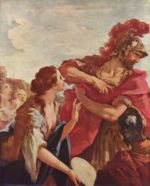 The Return of Jephtha (painting circa 1700–1725 by Giovanni Antonio Pellegrini)
The Return of Jephtha (painting circa 1700–1725 by Giovanni Antonio Pellegrini)
Haftarah
Generally
The haftarah for the parshah is Judges 11:1–33. Both the parshah and the haftarah involve diplomatic missions about land issues. In the parshah, Moses sent messengers and tried to negotiate passage over the lands of the Edomites and the Amorites of Sihon. (Numbers 20:14–21; 21:21–22.) In the haftarah, Jephthah sent messengers to the Ammonites prior to hostilities over their land. (Judges 11:12–27.) In the course of Jephthah's message to the Ammonites, he recounted the embassies described in the parshah. (Judges 11:17–20; Numbers 20:14–17; 21:21–22.) And Jephthah's also recounted the Israelites' victory over the Amorites described in the parshah. (Judges 11:20–22; Numbers 21:23–31.) Both the parshah and the haftarah involve vows. In the parshah, the Israelites vowed that if God delivered the Canaanites of Arad into their hands, then the Israelites would utterly destroy their cities. (Numbers 21:1–2.) In the haftarah, Jephthah vowed that if God would deliver the Ammonites into his hand, then Jephthah would offer as a burnt-offering whatever first came forth out of his house to meet him when he returned. (Judges 11:30–31.) The haftarah concludes just before the verses that report that Jephthah's daughter was first to greet him, proving his vow to have been improvident. (Judges 11:34–35.)
For parshah Chukat–Balak
When parshah Chukat is combined with parshah Balak (as it is in 2009), the haftarah is the haftarah for Balak, Micah 5:6–6:8.
For Shabbat Rosh Chodesh
When parshah Chukat coincides with Shabbat Rosh Chodesh (as it does in 2011 and 2014), the haftarah is Isaiah 66:1–24.
In the liturgy
The people’s murmuring and perhaps the rock that yielded water at Meribah of Numbers 20:3–13 are reflected in Psalm 95, which is in turn the first of the six Psalms recited at the beginning of the Kabbalat Shabbat prayer service. (Reuven Hammer. Or Hadash: A Commentary on Siddur Sim Shalom for Shabbat and Festivals, 15. New York: The Rabbinical Assembly, 2003. ISBN 0-916219-20-8.)
Further reading
The parshah has parallels or is discussed in these sources:
Ancient
- Ritual To Be Followed by the Kalu-Priest when Covering the Temple Kettle-Drum. Reprinted in James B. Pritchard, Ancient Near Eastern Texts Relating to the Old Testament, 334-38. Princeton: Princeton University Press, 1969. ISBN 0-691-03503-2.
Biblical
- Exodus 17:2–6.
- Leviticus 14:4–6, 49–52 (cedar wood, hyssop, and red stuff).
- Deuteronomy 2:4–8, 2:24–3:11; 10:6.
- 2 Kings 18:4 (bronze serpent).
- Psalm 51:9 (purge with hyssop); 78:15–16, 20, 35 (water from rock; they remembered that God was their Rock); 95:8–11 (Meribah); 105:2 (songs to God); 106:32–33 (Meribah); 135:10–12 (Sihon); 136:17–22 (Sihon).
Early nonrabbinic
- Josephus, Antiquities of the Jews 4:4:5–7, 5:1–3. Circa 93–94. Reprinted in, e.g., The Works of Josephus: Complete and Unabridged, New Updated Edition. Translated by William Whiston, 107–08. Peabody, Mass.: Hendrickson Pub., 1987. ISBN 0-913573-86-8.
- Hebrews 9:13–14 (red cow); 9:19 (scarlet wool and hyssop). Late 1st Century.
- John 3:14–15 (serpent); 19:29 (hyssop).
- Quran 2:67–73 (command to slaughter a heifer).
Classical rabbinic
- Mishnah: Shekalim 4:2; Rosh Hashanah 3:8; Megillah 3:4; Avot 5:6; Zevachim 14:1; Keritot 1:1; Oholot 1:1–18:10; Parah 1:1–12:11. Land of Israel, circa 200 C.E. Reprinted in, e.g., The Mishnah: A New Translation. Translated by Jacob Neusner, 256, 304, 321, 686, 729, 836, 950–81, 1012–35. New Haven: Yale University Press, 1988. ISBN 0-300-05022-4.
- Tosefta: Demai 1:14; Sukkah 3:11–12; Megillah 3:3; Chagigah 3:20; Sotah 4:2; 6:7; 11:1; Oholot 1:1–18:18; Parah 1:1–12:19; Makhshirin 3:15. Land of Israel, circa 300 CE. Reprinted in, e.g., The Tosefta: Translated from the Hebrew, with a New Introduction. Translated by Jacob Neusner, 1:81, 576, 644, 678, 844, 857, 877; 2:1655–1707, 1745–77, 1886. Peabody, Mass.: Hendrickson Pub., 2002. ISBN 1-56563-642-2.
- Jerusalem Talmud: Demai 31a; Kilayim 82a; Sheviit 47a; Terumot 58b; Yoma 1b, 2b, 23a–b, 47a. Land of Israel, circa 400 CE. Reprinted in, e.g., Talmud Yerushalmi. Edited by Chaim Malinowitz, Yisroel Simcha Schorr, and Mordechai Marcus, vols. 4–6b, 8, 21. Brooklyn: Mesorah Publications, 2006–2011.
- Babylonian Talmud: Berakhot 19b, 23a, 28a, 54a, 58a, 63b; Shabbat 16b, 28a, 48b, 51b–52a, 55b, 58b, 60b, 64a, 83b, 84b, 95b, 97a, 101b, 108a, 109a, 137a; Eruvin 54a, 58a, 64b, 67b; Pesachim 14b, 17b, 26b, 34b, 54a, 56a, 65b, 67a, 68a, 70a, 78a, 79a, 92a; Yoma 2a, 4a, 6a, 8a–9a, 14a, 41b–43b, 52b, 68a, 75b, 86b; Sukkah 6a, 21a, 25b, 37a–b; Beitzah 32a; Rosh Hashanah 3a, 29a, 31a; Taanit 9a, 13a; Megillah 6b, 20a, 29a; Moed Katan 5a–b, 7b, 14a, 15b, 28a–b; Chagigah 3b, 4b, 11a, 22a–23a; Yevamot 61a, 71b, 72b–73a, 74a, 75a, 116b; Ketubot 106a; Nedarim 37a, 55a; Nazir 6b, 19a, 44b–45a, 49b, 53b–54a, 61b, 64a; Sotah 12b, 16b, 38b, 46a; Gittin 38a, 53a, 57b, 76a, 86b; Kiddushin 25a, 30b–31a, 36b, 58a–b, 62a; Bava Kamma 2b, 25b, 82b, 98a, 101b, 105a; Bava Metzia 10b, 56b, 58a, 78b, 93a, 114b; Bava Batra 17a; Sanhedrin 4a, 5b, 43b, 47b, 77b, 101b, 110a; Makkot 8a, 11a, 13a, 14b, 21b; Shevuot 6b, 7b, 11b, 16b, 19a; Avodah Zarah 5b, 23a–b, 29b, 32b, 37b, 44a, 46b; Horayot 9b; Zevachim 14b, 17b, 22b, 25b, 32b, 33b, 40a, 43b, 68b, 78b, 80a, 93a–b, 105b, 112a, 113a, 118a; Menachot 6b, 7b, 19a, 27a–b, 51b, 76b; Chullin 2b, 9b, 11a, 13b, 23b–24a, 25a, 29b, 32a, 60b, 62b, 71a–72a, 81b–82a, 88b, 92a, 121a, 124b; Bekhorot 45a, 55a; Arakhin 3a; Temurah 12b; Keritot 2a, 25a; Niddah 5b, 9a, 44a, 49a, 55a, 61a. Babylonia, 6th Century. Reprinted in, e.g., Talmud Bavli. Edited by Yisroel Simcha Schorr, Chaim Malinowitz, and Mordechai Marcus, 72 vols. Brooklyn: Mesorah Pubs., 2006.
Medieval
- Avot of Rabbi Natan, 12:1; 29:7; 34:6; 36:4. Circa 700–900 C.E. Reprinted in, e.g., The Fathers According to Rabbi Nathan. Translated by Judah Goldin, 64, 120, 139, 150. New Haven: Yale Univ. Press, 1955. ISBN 0-300-00497-4. The Fathers According to Rabbi Nathan: An Analytical Translation and Explanation. Translated by Jacob Neusner, 89, 179, 205, 217. Atlanta: Scholars Press, 1986. ISBN 1-55540-073-6.
- Rashi. Commentary. Numbers 19–22. Troyes, France, late 11th Century. Reprinted in, e.g., Rashi. The Torah: With Rashi’s Commentary Translated, Annotated, and Elucidated. Translated and annotated by Yisrael Isser Zvi Herczeg, 4:225–68. Brooklyn: Mesorah Publications, 1997. ISBN 0-89906-029-3.
- Judah Halevi. Kuzari. 3:53. Toledo, Spain, 1130–1140. Reprinted in, e.g., Jehuda Halevi. Kuzari: An Argument for the Faith of Israel. Intro. by Henry Slonimsky, 181. New York: Schocken, 1964. ISBN 0-8052-0075-4.
- Numbers Rabbah 19:1–33. 12th Century. Reprinted in, e.g., Midrash Rabbah: Numbers. Translated by Judah J. Slotki. London: Soncino Press, 1939. ISBN 0-900689-38-2.
- Ecclesiastes Rabbah 7:23
- Zohar 3:179a–184b. Spain, late 13th Century. Reprinted in, e.g., The Zohar. Translated by Harry Sperling and Maurice Simon. 5 vols. London: Soncino Press, 1934.
Modern
- Thomas Hobbes. Leviathan, 3:33; 4:45. England, 1651. Reprint edited by C. B. Macpherson, 417, 675–76. Harmondsworth, England: Penguin Classics, 1982. ISBN 0140431950.
- Samson Raphael Hirsch. Horeb: A Philosophy of Jewish Laws and Observances. Translated by Isidore Grunfeld, 514, 574, 582. London: Soncino Press, 1962. Reprinted 2002 ISBN 0-900689-40-4. Originally published as Horeb, Versuche über Jissroel’s Pflichten in der Zerstreuung. Germany, 1837.
- Emily Dickinson. Poem 168 (If the foolish, call them "flowers" —). Circa 1860. Poem 597 (It always felt to me — a wrong). Circa 1862. In The Complete Poems of Emily Dickinson. Edited by Thomas H. Johnson, 79–80, 293–94. New York: Little, Brown & Co., 1960. ISBN 0-316-18414-4.
- Jacob Milgrom. “Magic, Monotheism, and the Sin of Moses.” In The Quest for the Kingdom of God: Studies in Honor of George E. Mendenhall. Edited by H. B. Huffmon, F.A. Spina, A.R.W. Green, 251–265. Winona Lake, Indiana: Eisenbrauns, 1983. ISBN 0931464153.
- Jacob Milgrom. The JPS Torah Commentary: Numbers: The Traditional Hebrew Text with the New JPS Translation, 157–84, 438–67. Philadelphia: Jewish Publication Society, 1990. ISBN 0-8276-0329-0.
- Mary Douglas. In the Wilderness: The Doctrine of Defilement in the Book of Numbers, xix, xxvi, 87, 100, 110, 112, 120–21, 123, 126, 130, 140–41, 147, 150, 159, 164, 166–67, 170, 188, 190–92, 199, 207–08, 211, 213, 215–16, 221, 226. Oxford: Oxford University Press, 1993. Reprinted 2004. ISBN 0-19-924541-X.
- Baruch A. Levine. Numbers 1–20, 4:455–95. New York: Anchor Bible, 1993. ISBN 0-385-15651-0.
- Avram Israel Reisner. “Curiouser and Curiouser: The Kashrut of Genetically Engineered Foodstuffs.” New York: Rabbinical Assembly, 1997. YD 87:10.1997. Reprinted in Responsa: 1991–2000: The Committee on Jewish Law and Standards of the Conservative Movement. Edited by Kassel Abelson and David J. Fine, 101, 105–06. New York: Rabbinical Assembly, 2002. ISBN 0-916219-19-4. (red heifer).
- William H.C. Propp. “Why Moses Could Not Enter The Promised Land.” Bible Review. 14 (3) (June 1998).
- Baruch A. Levine. Numbers 21–36, 4A:77–133. New York: Anchor Bible, 2000. ISBN 0-385-41256-8.
- Suzanne A. Brody. “Listen You Rebels.” In Dancing in the White Spaces: The Yearly Torah Cycle and More Poems, 98. Shelbyville, Kentucky: Wasteland Press, 2007. ISBN 1-60047-112-9.
- Hershel Shanks. “The Mystery of the Nechushtan: Why Did King Hezekiah of Judah Destroy the Bronze Serpent that Moses Had Fashioned To Protect the Israelites.” Biblical Archaeology Review, 33 (2) (Mar./Apr. 2007): 58–63.
- Sara Paretsky. Bleeding Kansas. New York: G.P. Putnam’s Sons, 2008. ISBN 978-0-399-15405-8. (red heifer plot element).
- Ari Z. Zivotofsky. “What’s the Truth about . . . the Parah Adumah?” Jewish Action, (Fall 2010): 77–78.
External links
Texts
Commentaries
- Academy for Jewish Religion, California
- Academy for Jewish Religion, New York
- Aish.com
- American Jewish University
- Anshe Emes Synagogue, Los Angeles
- Bar-Ilan University
- Chabad.org
- eparsha.com
- G-dcast
- The Israel Koschitzky Virtual Beit Midrash
- Jewish Agency for Israel
- Jewish Theological Seminary
- MyJewishLearning.com
- Ohr Sameach
- Orthodox Union
- OzTorah, Torah from Australia
- Oz Ve Shalom — Netivot Shalom
- Pardes from Jerusalem
- RabbiShimon.com
- Rabbi Shlomo Riskin
- Rabbi Shmuel Herzfeld
- Reconstructionist Judaism
- Sephardic Institute
- Shiur.com
- 613.org Jewish Torah Audio
- Tanach Study Center
- Torah from Dixie
- Torah.org
- TorahVort.com
- Union for Reform Judaism
- United Hebrew Congregations of the Commonwealth
- United Synagogue of Conservative Judaism
- What’s Bothering Rashi?
- Yeshiva University
- Yeshivat Chovevei Torah
Weekly Torah Portions Genesis Bereishit · Noach · Lech-Lecha · Vayeira · Chayei Sarah · Toledot · Vayetze · Vayishlach · Vayeshev · Miketz · Vayigash · Vayechi
Exodus Leviticus Numbers Deuteronomy Devarim · Va'etchanan · Eikev · Re'eh · Shoftim · Ki Teitzei · Ki Tavo · Nitzavim · Vayelech · Haazinu · V'Zot HaBerachahCategories:- Weekly Torah readings
- Book of Numbers
Wikimedia Foundation. 2010.

